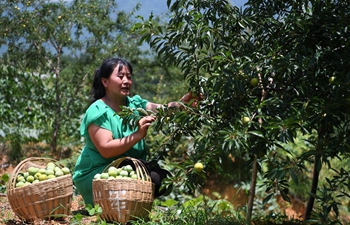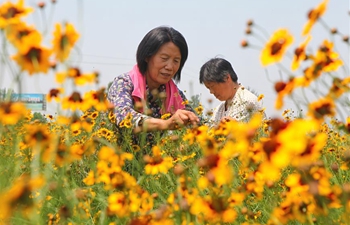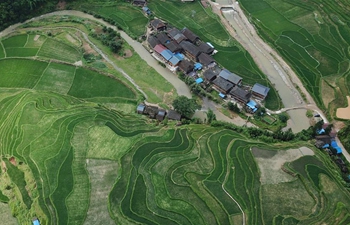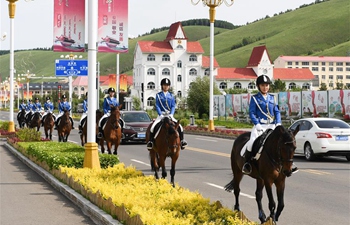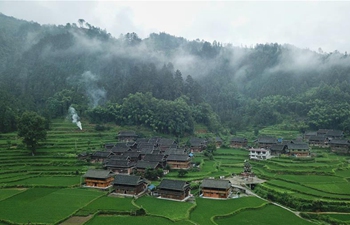LANZHOU, June 27 (Xinhua) -- In Dingxi, an arid city in northwestern Gansu Province, people once said "to plant a tree and make it survive is more difficult than raising a child."
But the situation has changed thanks to a national campaign - "returning farming land to forestry."
Trees have improved the environment, and brought extra income to Yang Wenrong, a farmer in Zhangwan village of Anding District.
High on the Loess Plateau, Yang's hometown is among withered mountain ravines with sparse vegetation and little rainfall. In his memory, local residents were always troubled by hunger and poverty.
"They lived at the mercy of the elements," Yang said. "If there were natural disasters such as drought or hail, not a single grain would be reaped."
Ecological degradation caused by humans has worsened the situation.
"In the past, we planted trees in spring and they died in autumn due to drought, or they were cut down by farmers for cooking or for heating," he said. Failing to produce grain, people continued reclaiming arid land, causing more serious water and soil losses.
Thanks to the national campaign, the government of Anding District has turned more than 1,500 farmers into part-time forest rangers since the early 2000s.
Yang joined them in 2014, taking care of a forest covering over 200 hectares near his home. He always rides a motorbike patrolling the mountain.
In addition to a herd of sheep and farmland that can provide him thousands of yuan each year, the new job offers him an annual salary of 20,000 yuan (around 3,000 U.S. dollars).
Besides recruiting forest rangers, the city of Dingxi has also taken other measures such as offering farmers free seedlings and paying them to plant trees.
The city has offered 1.2 million farmers seedlings free-of-charge every year since 2015, encouraging them to plant trees near their home. It also sends technicians to teach farmers how to look after trees and help rural cooperatives develop the fruit industry.
"Trees very likely die when they lack water. We have to take water up the mountains using vehicles. For the places where vehicles cannot reach, we carry buckets of water ourselves," said Cai Pengxiang, a technician from the district's foresty bureau.
Last year, local villager Gou Huijun got 40 free seedlings of lilac, walnut, jujube and pear from the government, planting them in his courtyard.
"They are strong enough to survive and bloom," he said, pointing to the 1-meter-high lilacs.
Inspired by Yang, Gou and his wife plant trees in the mountain every April. Over about 20 days, the couple plant 40 trees and more than 70 flower shrubs every day, earning themselves around 90 yuan per day.
The bare hills that were shrouded in dust 10 years ago have now been covered by trees. Vegetable plots with cucumbers and tomatoes sit around the village.
According to the forestry bureau of Dingxi, city residents have planted more than 19 million trees this year. By the end of 2016, the city's forest coverage rate had increased to 13 percent from 9.5 percent in 2000.
China has made afforestation one of its most important environmental projects. To combat climate change and soil erosion, the country aims to expand its forest coverage ratio to more than 23 percent by 2020, up from 21.7 percent in 2015.
The greener Loess Plateau has also become a paradise for wildlife. "The wild rabbits and pheasants rarely seen before have now appeared in the mountain. We could often spot them when we were patrolling the forests, and they wouldn't flee even seeing us," Yang said.




